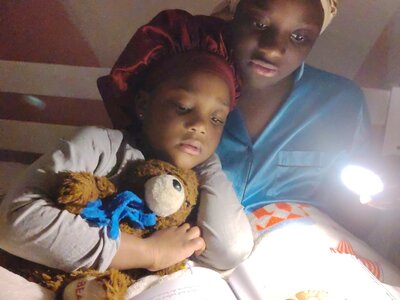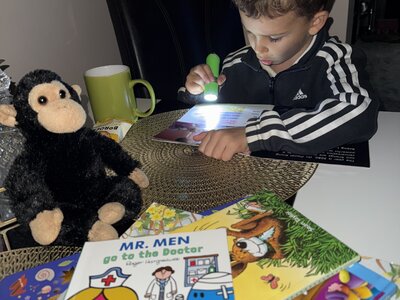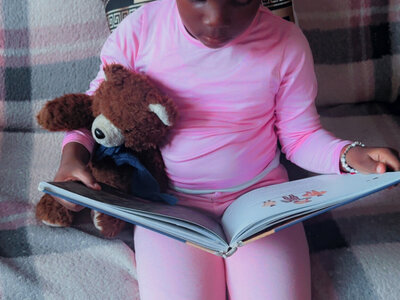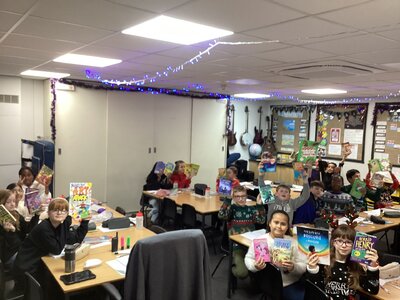The whole school was buzzing with excitement as the children visited the free book shop in school to choose a selection of books to keep. Thanks to The Children's Book Project the school gave away over 500 books for children to enjoy at home. The children loved spending time browsing the different titles and selecting their favourite stories or information texts.
Curriculum - English - Children's Book Project
How is phonics taught at school?
Essential Letters and Sounds (ELS) is our chosen Phonics programme. The aim of ELS is ‘Getting all children to read well, quickly’. It teaches children to read by identifying the phonemes (the smallest unit of sound) and graphemes (the written version of the sound) within words and using these to read words.
Children begin learning Phonics at the very beginning of Reception and it is explicitly taught every day during a dedicated slot on the timetable. Children are given the knowledge and the skills to then apply this independently.
Throughout the day, children will use their growing Phonics knowledge to support them in other areas of the curriculum and will have many opportunities to practise their reading. This includes reading 1:1 with a member of staff, with a partner during paired reading and as a class.
Children continue daily Phonics lessons in Year 1 and further through the school to ensure all children become confident, fluent readers.
We follow the ELS progression and sequence. This allows our children to practise their existing phonic knowledge whilst building their understanding of the ‘code’ of our language GPCs (Grapheme Phoneme Correspondence). As a result, our children can tackle any unfamiliar words that they might discover.
Children experience the joy of books and language whilst rapidly acquiring the skills they need to become fluent independent readers and writers. ELS teaches relevant, useful and ambitious vocabulary to support each child’s journey to becoming fluent and independent readers.
We begin by teaching the single letter sounds before moving to diagraphs ‘sh’ (two letters spelling one sound), trigraphs ‘igh’ (three letters spelling one sound) and quadgraphs ‘eigh’ (four letters spelling one sound).
We teach children to:
- Decode (read) by identifying each sound within a word and blending them together to read fluently
- Encode (write) by segmenting each sound to write words accurately.
The structure of ELS lessons allows children to know what is coming next, what they need to do, and how to achieve success. This makes it easier for children to learn the GPCs we are teaching (the alphabetic code) and how to apply this when reading.
ELS is designed on the principle that children should ‘keep up’ rather than ‘catch up’. Since interventions are delivered within the lesson by the teacher, any child who is struggling with the new knowledge can be immediately targeted with appropriate support. Where further support is required, 1:1 interventions are used where needed. These interventions are short, specific and effective.
Here is a typical phonics lesson at our school.
Reception Parents - Phonics Information Morning
We were delighted to welcome reception parents and our chair of governors into school for our phonics information morning.
Our English and phonics leaders delivered a presentation to parents outlining our approach to teaching phonics using the 'Essential Letters and Sounds' programme and how they could support their children with reading at home.
Parents then enjoyed time with their children playing phonics games and reading a range of books.
Thank you to all parents who visited and for your really positive feedback.
"That was really beneficial and very detailed. It's good to know exactly what is been taught to my child and how." (Reception parent).
Phonics - Screening Check
Phonics - A Parent Guide - Learn to Read with Phonics
If you have a child in their first year of primary school, there is a good chance you will have come across the word 'Phonics'.
Phonics is a method of learning to read words that is taught from the start of Reception.
Read on to find out how your child uses phonics at school, how to correctly say the 44 phonics sounds, and how you can help at home.
What is synthetic phonics?
Synthetic phonics is a way of teaching reading. Your child will be taught two crucial things when they are learning to read using synthetic phonics:
- How sounds are represented by written letters. For example, they will be taught that the letter ‘m’ represents an mmm sound.
- How sounds can be blended together to make words. For example, they will be taught that the sounds of the letters ‘c-a-t’ blend together to make the word ‘cat’.
Your child will be taught to read letters or groups of letters by saying the sound (or sounds) they represent. For example, they will be taught that the letter ‘l’ sounds like lllll when we say it. Your child will then start reading by blending the sounds together to make words. Another word for this kind of blending is synthesising.
Phonics - Useful Parent Documents
Phonics - Supporting Reading at Home
-
Children will only read books that are entirely decodable, this means that they should be able to read these books as they already know the code contained within the book.
-
We only use pure sounds when decoding words (no ‘uh’ after the sound)
- We want children to practise reading their book 4 times across the week working on these skills:
- Decode – sounding out and blending to read the word.
- Fluency – reading words with less obvious decoding.
- Expression – using intonation and expression to bring the text to life!
We must use pure sounds when we are pronouncing the sounds and supporting children in reading words. If we mispronounce these sounds, we will make reading harder for our children. Please watch the videos below for how to accurately pronounce these sounds.
At the beginning of each academic year, we will hold an information session for parents and carers to find out more about what we do for Phonics, Reading and English at our schools. Please do join us.
More support for parents and carers can be found here:
Essential Letters and Sounds Website Link
ELS - Phase 2 Pronunciation Video
ELS - Phase 3 Pronunciation Video
ELS - Phase 5 Pronunciation Video
At St Bartholomew’s we consider Reading to be ‘The Master Skill’ as it allows children to acquire an array of new knowledge and skills from across the wider curriculum. Reading fiction texts allows children to ‘get lost in a book’ and immerse themselves into the wonderful world of their imagination. We aspire to ensure that all children leave our school reading to the very best of their ability and ready for the challenge of the next stage in their education.
Reading is a big part of what we do in school on a daily basis – reading is incorporated into everything we do.
We read individually, in pairs and in groups across school, depending on a child’s individual needs. In Early Years and Key Stage 1, we use a range of strategies, in addition to phonics, such as a variety of decoding methods, teaching high frequency words through sight recognition and discussion through picture books. Reading ambassadors from Year 5 go and read with the children in other classes – a treat to watch! We read in lessons, in assemblies and at every other given opportunity. Businesses’ volunteers enhance our reading provision every week hearing our vulnerable readers.
Reading comprehension is taught as a whole class during daily timetabled lessons. In these sessions there is always an emphasis on vocabulary and one other reading domain. Novels are used to teach reading as well as a range of non-fiction texts. These texts are carefully chosen to ensure that there is progression and challenge across the school- there is also clear links between reading and writing as the same texts are used to facilitate both.
It is vital that our children not only read, but that they are read to, therefore teachers read a variety of high-quality texts to the children on a regular basis. Listening to the change in tone, and different voices, can make it very exciting and appealing. Children love listening to stories, no matter how old they are. We share books, talk about books, visit the library…we make it a special time to sit and read together. It is also lovely and relaxing activity for the children to read independently, so we allocate time for children to sit and read a book they have chosen for pleasure. We are lucky that our children have access to a range of different books in our local library and class book corners from Nursery to Year 6.
In school we also have and celebrate:
- Reading challenges – in classes, year groups and sometimes for the whole school
- Reading Ambassadors
- First news and Wizz Pop Bang science magazine delivered to every KS2 classroom
- Book Week
- Book Fairs
- The Summer Library Challenge
St Bart's Reading Spine
The reading spine contains a core set of texts that are read by children each term in school. Some form part of the English curriculum and others are read in story time sessions.
Children across school read a wealth of quality texts throughout the year. These include stories, non-fiction texts and poetry which are related to topic areas. Additionally, there are others that are for wider enjoyment and relate to the interests of children – these can change each year, and are therefore not included in the reading spine.
The texts in the reading spine have been chosen carefully to ensure they promote key principles such as equality, courageous advocacy, British values and develop positive SEMH. Texts in the reading spine are organised into the following themes:
- Topic
- PSHE
- Diversity
- Picture Books
- Poetry
Shared Reading
Reading with your child gives you special time together and helps develop your child’s language skills and imagination, creates happy memories and a lifelong love of reading.
Below are parent guides on shared reading:
Shared Reading Guidance
Reading Guides
Reading Aloud
Why should we keep reading aloud to kids even when they can already "read on their own"?
This talk demonstrates the magic of read aloud and reminds us all why reading aloud is so essential - at school and at home. This talk is for parents and teachers who want to teach comprehension and connect with kids in powerful ways.
Curriculum - Phonics & Reading - Chair of Governors Visit
It was wonderful to have a visit from Sheila Banks (our Chair of Governors) today. She enjoyed watching a phonics lesson in KS1 and working with children in class 5 as part of an Oracy lesson in Geography.
Curriculum - Phonics & Reading - Book Reviews (Class 15)
Class 15 have worked hard on their book reviews. George won the class vote. Well done George!
Curriculum - Phonics & Reading - World Book Day 2024
Class 7 really enjoyed world book day, they dressed up as their favourite characters and read the book Room on The Broom. They learnt the rhyme in the book and the children were able to join in with the repetition. They wrote book reviews, new pages for their own versions of the book, with new characters and even illustrated them. We also had a visitor. She helped the children make informed choices about rhyme to help them create their own performance poem. They then learnt actions to the poem before preforming it to the rest of key stage one in assembly at the end of the day. They had an amazing time and learnt a lot in the process.
Curriculum - Phonics & Reading - Poetry Workshop
Well done to all of KS2 who created wonderful poems with our workshop to celebrate World Book Day.
Curriculum - Phonics & Reading - Book Reviews
These are the book and character review competition entries for class 13! Followed by the two winners Liepa and Sophia! Well done girls, check out their reviews in the second picture.
Curriculum - Phonics & Reading - Year 1 / Year 2 Reading Areas
Children in key stage 1 have enjoyed reading stories together at playtime and lunchtime in our special reading areas.
Children in year 2 have loved reading a wide range of pirate themed books in book club this week with Mrs McCaffrey. They have brought in their own books from home to share with their friends and talked about the characters and plot of the different stories. Children have compared books and participated in some fantastic discussions around prediction.
Reading Rucksacks
Classes 1 to 6 have their own 'Reading Rucksacks' to help encourage children to read for enjoyment over the weekends.
Each weekend 2 children from each class will have the opportunity to take home the rucksack to enjoy with their grown ups. Inside the rucksack there are a range of stories for grown ups to share with children and lots of other exciting things such as a torch, a cuddly toy and a treat!
Look out for pictures on the website of children showing how much they love reading!
5 Top Tips for Reading Together with your Nursery Child
- Share books little and often. A great time to do this is as a bedtime story, every evening. Find somewhere comfortable and put away any distractions such as mobile phones.
- Let your child choose the book. Encourage your child to hold the book themselves and turn the pages. Re-read favourite books and stories.
- Talk about each part of the book. Some useful ideas are:
- Look at the cover – what do you think the book is about?
- Talk about what you see in the pictures.
- Get them to say what might happen next.
- Talk about how they think the story will end.
- Discuss how the characters may be feeling and how the book makes your child feel.
- Encourage your child to join in with the story through repeated words and phrases in the story or rhyming words. Young children love to learn their favourite stories off by heart and repeat them back to you – this is great for developing their writing skills when they get older, so do not be afraid to read their favourite books over and over again!
- Most of all, remember reading is fun and you can share a story just by looking at the pictures and talking about what is happening.
We would love to hear about your home reading time. Feel free to post pictures or videos of your child reading their favourite story on Learning Journal or send them to nursery email address: nurseryhw@stbartsleeds.org.uk.
.png)
.jpg)






.jpg)



.png)
